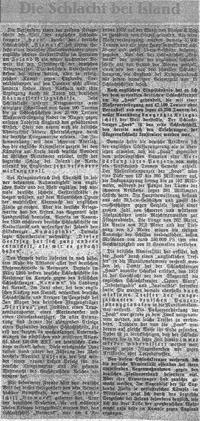
UNKNOWN NEWSPAPER

The Battle at Iceland
(Translated from the German by Ulrich Rudofsky and Andreas Müller)
From our naval correspondent Erich Glodschey
The sinking of one of the greatest warships of the world, the English battle cruiser “Hood” by the German battleship “Bismarck” in a battle between a German fleet unit against an English heavy naval force in the sea region off Iceland is a new shining proof of the offensive spirit of German naval war forces.
The German U-boats do not stand alone in their hard, but successful fight in denying England’s (access) to the sea lanes of the Ocean.
In particular, they find backup and complete support through actions of German surface warships.
Every class of ship of our naval forces from minute E-boats of barely 100 tons to battleships with 35,000-tons of displacements find valuable deployment in the struggle against our mortal enemy England.
Time and again the British Admiralty must experience frustrating surprises (caused) by German naval forces.
In connection with this severe blood letting, the English fleet is currently suffering from German bombing raids in their defense of Crete in the eastern Mediterranean Sea, and thus the victorious strike at Iceland in the North Atlantic now hits the English with special effectiveness.
At the outbreak of the war Churchill proclaimed in his well-known propaganda speeches to the English people and the world that German naval forces have never dared to challenge the materially superior power of the English fleet on the Atlantic Ocean.
But the German navy has proved the opposite to the British.
Already in 1939, German battleships appeared in the North Atlantic and sank the auxiliary cruiser “Rawalpindi” near Iceland.
At that time, Chamberlain said in sorrow, “This naval war developed quite differently than we anticipated.”
The proof of this was delivered in even higher measure through the actions of all three branches of the German armed forces in Norway.
At that time, in March 1940 German battleships patrolled the North Sea and engaged the British battle cruiser “Renown” during the landing in Narvik.
However in June, during the English retreat from Narvik, German battleships and cruisers in a sea battle at Ian Mayen sank the British aircraft carrier “Glorious”, two destroyers, a troop transport, one navy tanker, and a submarine chaser.
In everyone’s memory are further splendid successes of a unit of German battleships that recently sank more than 130,000 tons (brutto registered tons) of enemy tonnage after a week-long cruise of the northerly and central Atlantic.
These successful operations were under the command of the Chief of the Fleet Admiral Lütjens, who has again accomplished a new glorious achievement for the German Navy and the entire armed forces of the Greater German Reich.
With special joy, the German Nation now hears proof of the superior fighting power that was demonstrated by the battleship “Bismarck”.
The “Bismarck” was launched 14 February 1939 at the yard of Blohm & Boss (sic) (to read: Voss) in Hamburg, and is one of the German units which were completed since the beginning of the war.
It has a reported water displacement of 35,000 tons, eight 38 cm and twelve 15 cm guns.
Recently, the battleship “Bismarck” sent the largest English battleship to the bottom of the sea, one of only three battle cruisers that England possessed at the opening of hostilities, from a previous total of 15 battleships.
According to English admissions, the sunken battle cruiser is the “Hood,” which is the largest warship in the world with its displacement of 42,000 tons excluding fuel and notably 45,200 tons when fully loaded.
The battle cruiser “Hood” is the first battleship was constructed following the experiences gained during the Battle of the Skagerrack.
At that time, German firepower proved itself superior against English ship armor, so that “Hood”, in contrast to the original construction plan, received additional re-enforcement to its armor weighing more than 5000 tons.
The waterline armor of the “Hood” has a thickness of 127 to 305 millimeters, the deck armor plating is up to 102 millimeters, while the turret armor of the heavy artillery has a thickness of up to 381 millimeters.
The main armament consisted of eight 38.1 cm guns and twelve 14 cm guns for use against sea targets, as well as numerous heavy to medium anti-aircraft guns and machine guns for air defense.
The length of 262 meters, the breadth of 32.2 meters and the draught of 8.7 meters demonstrate the immense size of this ship whose engines of about 150,000 horsepower gave it a speed of 31 knots.
The British Admiralty has explained that the “Hood” was sunk by an “unlucky (sic) hit” to its munitions compartment.
With this hit, the battle cruiser “Hood“ suffered the same misfortune that was inflicted upon the English battle cruisers “Queen Mary”, “Indefatigable”, and “Invincible” during the Battle of the Skagerrack.
At that time, they were similarly sunk by effective hits to the munitions compartment by the remarkable German armor piercing grenades.
The armour reinforcements of the “Hood” were precisely designed for the purpose of preventing such strikes.
Nevertheless the “Hood” found her demise in a similar manner.
One also has to take into account the battle cruiser was being modernized up to the last minute against aerial bombs as well as against artillery- and torpedo strikes.
The British admiralty obviously had especially great faith in these comprehensive countermeasures against the German Fleet.
But their expectations were not realized.
Currently, the ongoing heavy battle loses of the English fleet in the Mediterranean together with the victorious sea battle off Iceland demonstrates especially clearly how the three branches of the Greater German Armed Forces complement each other in the fight against England.
Back to: Printing Press | On-line Archive
|




